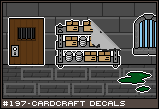| Three Hundred |
| - Index Page |
| - About... |
| - By Year |
| Collections |
| - Comp-Grid |
| - Procedural |
| - Tactics |
| - Tiny Crawl |
| - Misc |
| Previous | Mechanic #197 | Next |
This is an extension to [#132 - Cardcraft] (see also: playable prototype), which was an attempt to build a Minecraft game that resembled a board game. First, a quick refresher:
![[cardworld1.png]](set10/img/entry197-cardworld1.png)
The Cardcraft world is built into cells, with each cell having a stack of cards. Gathering resources is accomplished by popping off the top card of the stack. These resources are then spent at the store to acquire new, random world cards, which can then be pushed on top of a card stack to create a new facing card. My problem with how Cardcraft turned out is that there wasn't really any crafting. Instead, you spent resources to buy cards randomly from specific stacks that had the cards you wanted. For instance, if you wanted a pick axe, you would buy a card from the pick axe stack and get a random pick axe card representing various qualities of pick axe. The same thing for the world cards, meaning that you had little control over what you had available to build.
![[decal1.png]](set10/img/entry197-decal1.png)
The first change to the idea is that rather than having different stacks that you buy from using your resources, you instead buy booster packs of ten cards. These booster packs come in themed sets, not unlike CCGs. So you can get a booster from the Core Set box or a booster from Foreboding Castle box. Each set has a unique set of cards that come in common, uncommon, and rare distribution. Booster packs are bought with money, the sort of universal resource that you can get by selling off your other resources like rock and dirt. Getting a card doesn't mean that you can use it yet. You still have to pay the resource requirements on the card to activate it. So, even if you get the super rare Diamond Pickaxe tool card, you can't use it until you have the diamond resources available to build it.
![[decal2.png]](set10/img/entry197-decal2.png)
In addition to room and tool cards, some cards are sticker sheets. These cards are part of the card set just like the others, so they come in common, uncommon, and rare distributions as well. However, they are not cards in the same way that the others are because they can not be directly applied to the game world as a room or tool. Instead, they are used to improve cards already in your collection.
![[decal3.png]](set10/img/entry197-decal3.png)
A large majority of the common cards you'll find in each booster pack will be empty rooms that will be up to you to design by applying stickers to it. Each sticker you apply to a room card will contribute something new to the card, such as new functionality or additional coolness. For instance, placing window stickers will give the room a light source (during the day). A box will add storage capability to the room. Other stickers simply increase room attributes, like style +1 or foreboding +1. These attributes are important because some stickers or rooms can not be placed unless the requirements are met. For instance, you can't place the vampire bat sticker in a room that doesn't meet the minimum darkness and foreboding requirements. Once you are done applying stickers to a room card, you can build the room card by using resources. The stickers may add additional resource requirements. For instance, you add a box sticker to the room and the room now costs an addition 2 wood. Once you've paid the cost, you can place the room on a card stack. The difference this time is that you are not required to build on top of empty rooms first.
|
